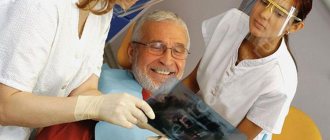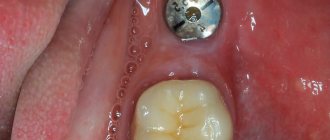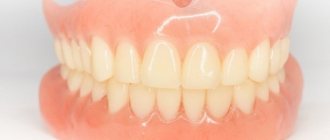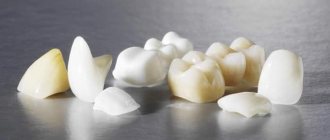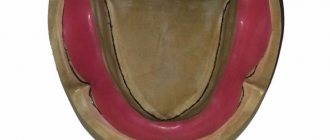It is also possible to restore lost teeth using traditional prosthetics, which is significantly cheaper than implantation, but this ends the advantages of conventional dentures over implants. The thing is that the implant is considered a full replacement of the tooth root, and the classic prosthesis is only an imitation of its coronal part. "What's the difference?" - you ask. An expert in the field of prosthetics on implants, an orthopedic dentist at Smile-at-Once innovative technologies dentistry in Moscow, answers in an interview with Startsmile.
What is implant prosthetics?
There are many methods for restoring teeth in dentistry.
Each of them has its advantages and helps solve a specific problem. However, implant prosthetics are considered the most effective. The basis of the method is the implantation of titanium pins into the jawbone, which replace the roots of natural teeth. An orthopedic structure is installed on top of the pin, depending on the condition of the dentition.
The technology is applicable to restore one tooth, several dental units in a row, or the entire jaw at once. In the first case, an artificial crown is fixed on the implant, a bridge structure is used to replace 2-3 teeth, and when all teeth are restored, a fixed or removable prosthesis is used. The doctor selects the material for the orthopedic design based on the method of installing the prosthesis, the preferences and financial capabilities of the patient.
Types of prosthetics:
- Classic dental implantation. Suitable for cases where 1-2 teeth from a row are missing. Can be with delayed or immediate loading, with installation in one or more stages.
- All teeth in 1 day. It is used in cases of complete edentia (loss of teeth). Offers several solutions, depending on the structure of the jaw and the condition of the bone tissue. This can be the installation of All-on-4, All-on-6 protocols or simultaneous implantation.
Pros of technology
Some will say that dental implantation is very expensive. But if you evaluate the result in perspective, it turns out that this is a profitable investment in your own health for the next 20-25 years.
Judge for yourself: the service life of prostheses on implants is 2-3 times longer than traditional designs. And the titanium pin ensures an even load on the jaw, while maintaining chewing and speech functions.
In addition, the use of implants when installing dentures allows you to restore any number of teeth, regardless of their location in the oral cavity.
In case of edentia (complete absence of teeth), implants can be used to place not only a removable, but also a permanent orthopedic structure, which in its properties is much more convenient and reliable.
An even load on the upper and lower jaw eliminates bone tissue atrophy and subsequent problems with natural teeth. In addition, implant prosthetics do not use healthy teeth. Nothing is attached to them; natural teeth do not need to be ground down, which significantly extends their life.
Dentures are comfortable to wear: they do not injure the gums, do not distort diction, and do not shift under load.
But the main advantage is the high level of aesthetics. All types of dentures installed on implants look like real teeth.
What are the advantages of implantation with complete edentia?
The main advantage of an implant-supported prosthesis is the reliability of its fixation. Such a denture will never fall out of your mouth at the most inopportune moment. In cases of wearing a complete removable denture, this happens quite often, since the structure is held in the oral cavity due to the suction effect of the palate, the protrusions of the jaw bone and the force of gravity (on the lower jaw). As for fixing gels, they only help if the error between the prosthetic bed and the prosthesis itself is minimal. If a person has not repositioned an orthopedic structure for more than two to three years, to securely fasten it, it will be necessary to squeeze out half a tube of the product (and it is quite expensive), which is “eaten up” within 5–6 hours, and this, in turn, is fraught with serious gastrointestinal disorders.
It is worth noting that there are a number of methods for improving the fixation and stabilization of such a prosthesis, but no matter how masterfully the doctor masters prosthetic techniques, with complete edentia, wearing a classic complete removable denture still significantly reduces the patient’s quality of life. In addition, a removable prosthesis leads to further atrophy of bone tissue, which not only complicates the implantation procedure in the future, but also makes the manufacture of a new prosthesis problematic.
Types of prostheses on implants
In general, implant-supported prostheses are divided into two types:
- Removable.
- Fixed.
The first type differs significantly from analogues of classical prosthetics. Traditional structures are fixed exclusively on the gums, or attached to supporting teeth. Thanks to implants, removable dentures are securely fixed in the jawbone, but they can be removed if necessary. That's why they are called conditionally removable.
Fixed dentures are considered a more durable and optimal option for dental restoration. In addition to the artificial crown, some types of structures are equipped with a base made of elastic plastic, which imitates natural gums.
Fixed dentures can be used to replace any number of teeth, even if they are located in different parts of the dentition. We will talk in more detail about each type of prosthesis a little later.
There are also temporary dentures that are installed during the period of fusion of the implants with the jawbone. They maintain the aesthetics of the dentition and reduce the mechanical load on the pins, speeding up the healing process.
Temporary dentures look like removable structures that hook onto supporting healthy teeth using hooks. The most common option is a butterfly-shaped prosthesis. It is equipped with a plastic gum and two plastic holders for adjacent teeth. A denture replaces one or more teeth in a row.
Installation steps
The reliability of implant-supported dentures directly depends on the location of fixation. Especially when it comes to restoring all teeth. Correct placement of implants will ensure uniform distribution of chewing load on the jaw and allow the use of a minimum number of pins. This reduces the recovery period and the degree of surgical intervention during installation.
At the initial stage, the implantologist performs an initial examination of the oral cavity. In EspaDent clinics, to select a prosthetic method, additional diagnostics are carried out using a modern Orthophos SL 3D tomograph, which takes three-dimensional, layer-by-layer images of both jaws. Professional equipment allows you to simulate the treatment process and show the patient the final result.
In the absence of contraindications, the doctor proceeds to the next stage of prosthetics on implants - fixation of titanium pins in the jawbone. The procedure takes 40-60 minutes for each implant. It is carried out using anesthesia. Our specialists use safe painkillers. They are non-toxic and do not cause allergic reactions.
The pin fixation process includes:
- Gum section.
- Preparing the space in the jawbone.
- Implant installation.
- Gum stitching.
The period of fusion of the pin with the bone tissue takes 3-4 months. During this time, the patient is fitted with temporary removable dentures, which we discussed above.
After the healing process is completed, the doctor installs a gum former and takes an impression of the teeth. After a couple of days, the adapter is replaced with an abutment, on which the finished denture is fixed.
Cost of full dental implantation
Similar treatment in Moscow dentistry, including all accompanying procedures, is offered at a cost of 180,000 rubles and more. The price of implantation in the absence of teeth will be higher if a larger number of implants are installed, and more expensive materials are used to make the prosthesis itself. In any case, even the cheapest prosthetics on implants will be an order of magnitude better than a classic removable denture, which significantly reduces a person’s quality of life, especially when it comes to elderly patients.
How long does implant prosthetics take?
The duration of installation of prostheses on implants depends on the clinical situation. After performing a tomography of the jaw, the doctor assesses the condition of the bone tissue. Depending on the degree of jawbone atrophy, the implantologist may prescribe an osteoplasty procedure.
The period of prosthetics on implants is determined by the rate of bone tissue regeneration, as well as the chosen installation technique. For example, the healing period of implants in the upper jaw takes, on average, 3-4 months. For the lower jaw a little less - 2-3 months.
If a procedure is carried out to restore bone tissue due to atrophy, then another 2-4 weeks are added to the installation of prostheses.
CHOOSE THE PROSTHETIC WITH IMPLANTS THAT WILL FIT YOU PERFECTLY!
Dental clinic "Bionic Dentis" is an expert clinic in installing dentures on implants of various modifications. We have been working with this technique since 2006 and have one of the largest experiences in this area in the Russian Federation and the CIS countries.
Over the past 7 years, we have been included in the TOP 10 best dental clinics in Moscow and the Moscow region according to the independent portal 32top.ru
We are the official authorized partner of the Swiss company Nobel Biocare, which ensures that you install only original implants at the best price and with the maximum warranty period.
The clinic’s doctors are highly qualified and experienced, have undergone training in Europe and Israel, and are certified specialists in all modern methods of implant prosthetics.
IN THE PHOTO: CHIEF DOCTOR OF THE BIONIC DENTIS CLINIC OZEROV PETER VLADIMIROVICH
Our doctor is an implantologist-orthopedist Petr Vladimirovich Ozerov, an official expert of the French company BIOTECH in the Russian Federation. Dr. Ozerov has 17 years of clinical experience in installing prostheses on implants. The doctor is certified by Nobel Biocare:
is a Full Member of the Russian Association of Dental Implantology Since 2012:
The highest qualifications of this specialist guarantee you high quality implantation and prosthetics. Based on the results of patient voting in 2022, the doctor took 3rd place in the ranking of prosthetics and implantation specialists:
Petr Vladimirovich has a certificate in orthopedic dentistry and surgical dentistry, this gives him the right to carry out both implantation and prosthetics himself, without the involvement of third-party doctors. This gives a better result than if such work is done by 2 different doctors: the orthopedist installs the prosthesis, and the implantologist performs the implantation operation. In the case when one specialist carries out all the work on prosthetics and implantation independently, the result is much better, since the doctor has broader clinical thinking and is familiar with all the intricacies of both the surgical protocol and the prosthetics protocol.
IN THE PHOTO: TOTAL PROSTHETICS USING PROSTHETICS ON IMPLANTS. IMPLANTOLOGIST-ORTHOPEDIST OZEROV PETER VLADIMIROVICH
Prosthetics using removable structures
When is it advisable to use removable dentures on implants? Often the argument is limited budget. Removable structures are much cheaper than permanent ones, especially in the case of complete edentia.
The method is effective for severe atrophy of the jaw bone, if the patient is not ready to undergo a sinus lift of the jaw. A denture with artificial gum will hide imperfections in the contour of your own tissues.
Conditionally removable structures are fixed to implants in two ways: screw or beam. In the second case, a metal structure in the form of a beam is used, on which artificial teeth are installed. The beam serves as the base of the prosthesis and ensures uniform distribution of mechanical load on the bone. Due to the single design, the prosthesis is more stable.
Both options for fixing the prosthesis can be removed if necessary (for cleaning, etc.). However, only a dentist should do this.
What is the difference between classic removable dentures and those installed on implants? The design with pins is smaller in size and has better fixation in the oral cavity, which ensures comfortable wearing.
The absence of a palate in the prosthesis preserves taste sensitivity when eating food, without any restrictions.
The ability to remove the prosthesis extends its service life and allows for timely cleaning and replacement of elements, if necessary.
Lower cost makes this type of implant prosthetics accessible to most patients.
If we talk about size, fixed dentures are more neat and compact. From an aesthetic point of view, removable ones are also inferior to non-removable ones. The latter do not have artificial gums.
To make crowns in removable dentures, the following is used:
- Plastic (for temporary fixation).
- Ceramics.
- Zirconium dioxide.
All materials have increased strength and high aesthetics. At EspaDent clinics, crowns are made using digital CAD/CAM technology. The automatic production mode eliminates the occurrence of errors associated with the human factor. Dentures take into account the anatomical structure of the patient’s jaw and the location of adjacent teeth. Their installation does not change the bite, does not deform the masticatory muscles, and does not cause facial asymmetry.
Removable prosthetics using implants
In addition, with a completely toothless jaw, the implantation of implants is sometimes the only chance to avoid wearing a removable laminar denture.
In a situation where there is a need for removable dentures (for example, when all or most of the teeth on the jaw are missing), the implantation of several implants allows for a strong fixation of the structure . In addition, with a completely toothless jaw, implantation is sometimes the only chance to avoid wearing a removable plate denture, which is fixed in the mouth by suction and, of course, performs its chewing function much worse.
Removable dentures supported by implants are held securely in place. Thanks to the presence of support points , it becomes possible to use modern clasp removable dentures, which are a metal arch with artificial teeth . Such dentures do not interfere with articulation (pronunciation of sounds), they are not noticeable in the mouth (unlike plate structures, the basis of which occupies almost the entire hard palate).
Finally, removable dentures on implants, fixed to support points using modern attachment locks, are not inferior to real teeth in aesthetic terms.
Fixed structures
As a rule, crowns or bridges are used for permanent dental prosthetics on implants. A single denture most accurately replicates the shape and appearance of the missing tooth. Using single crowns, the implantologist corrects the gum contour, making it almost ideal. This is especially true for the front teeth that fall into the smile zone.
A bridge structure is used to restore several teeth. It is necessary in cases where it is not possible to install 2-3 implants in a row due to lack of space.
The difference from a traditional bridge lies in the method of fastening. The structure receives additional support in the form of pins and does not affect adjacent healthy teeth. In other words, there is no need to grind down your natural teeth and attach a prosthesis to them.
The advantages of the technique include the maximum degree of stabilization of the prosthesis, high aesthetics and a tight fit of the structure to the gum, which eliminates its damage and the ingress of food debris into the prosthesis.
The only disadvantage of fixed dentures on implants is the price. But in fact, this is the most profitable investment in your own health. The durability of the implants and the lifetime guarantee for their installation only confirms the quality of the technique.
Fixed dental prosthetics
How does the process of dental implantation occur
? An alternative method of prosthetics in the absence of one or more teeth is prosthetics using dental bridges. In this case, the crown “suspended” on the supporting teeth serves only an aesthetic role. the supporting teeth suffer from excess load , and the bite may be disrupted.
The use of a prosthesis on an implant will allow you to fully use the artificial tooth: it will be indistinguishable from the “native” ones, neither visually nor functionally.
Restoration of teeth with complete edentia
The method of fixed prosthetics effectively copes with the problem of complete absence of teeth. For example, All-on-4, All-on-6 protocols or simultaneous implantation.
The All-on-4 protocol involves the installation of four implants in the jaw: two in the frontal part, two on the sides, at an angle of 45 degrees.
The technology provides instant chewing load, immediately after fixing the prosthesis. Installation of the prosthesis is possible immediately after implantation.
If the patient has severe jawbone atrophy, the All-on-6 protocol is used. An additional number of implants ensures reliable fixation of the prosthesis even with insufficient bone tissue.
But be careful! Due to the popularity of the technology, many fakes have appeared. Poor quality materials and unprofessional work can lead to serious health complications and loss of money.
EspaDent is an official partner of Nobel Biocare, a leader in implantology and developer of protocols for dental restoration in 1 day.
In 2016, with the support of Nobel Biocare, our clinic created its own Center for implantation and complete dental prosthetics, which provides training to specialists from all regions of Russia.
Materials for dentures
To attach prostheses to implants, the material must be highly durable or have a metal base. This is necessary for the structure to withstand the load of the abutment (adapter).
Crowns for fixed structures are made from metal-ceramics, composite, metal-plastic, and also from zirconium dioxide. The prosthesis is attached using cement or screws.
Composite crowns for implants with a metal frame are used for single replacements, as well as for the installation of bridges. The design has a long service life (10-12 years) and is subject to repair. Reliable, lightweight, with a high degree of aesthetics, composite crowns are comfortable to wear and look like real teeth.
Plastic removable dentures last no more than 5 years and are used only for temporary or adaptive prosthetics. At EspaDent clinics, our specialists use more technologically advanced plastic for temporary prostheses. The composition contains crushed diamond chips, which makes the structure more resistant to stress during the fusion of the implant with the bone.
Fixed prosthesis is made of zirconium or metal ceramics. This is due to the high reliability of the design. Crowns for implants cannot be restored, as is the case with composite ones, so they must be as strong and durable as possible. For metal-ceramics, the service life is 8-10 years, and zirconium is a little longer - 15-17 years.
The disadvantages include the imperfect aesthetics of ceramic crowns - the metal base can be visible in the light. Therefore, it is better to use them to restore lateral teeth.
Zirconium dioxide crowns have almost no disadvantages. Decent service life, impeccable appearance, increased material strength, absence of allergic reactions even in patients with high sensitivity. Of course, such prostheses are more expensive than their analogues.
Contraindications
It is obvious that implant prosthetics is a complex and expensive procedure. Therefore, even at the initial stage, it is important to eliminate all possible risks for the patient.
The reason for refusal or delayed treatment may be jaw deformation, pathological atrophy of bone tissue, bruxism, increased tooth wear, and malocclusion. Contraindications to surgery are also diseases of the nervous system, bleeding disorders, reduced immunity, intolerance to painkillers, and the presence of tumors.
Care instructions
In order for implant-supported dentures to last as long as possible, they require careful care. Each patient receives written information about how to care for fixed or removable dentures after the procedure.
Special toothpastes and brushes are used to clean dentures. It is easier to take care of removable structures, because... You can easily remove the prosthesis. For this purpose, it is recommended to visit the dentist's office, who will professionally clean the dentures.
To remove food debris from interdental crevices and hard-to-reach places in the structure, you need to use dental floss, brushes and irrigators.
Remember, proper care of the prosthesis and careful use significantly extends its service life.
Care of prosthetic structures on implants
Hygienic care is not difficult, but must be carried out regularly and carefully. This is the only way to hope for longevity. Obviously, during care, the implants themselves are not cleaned, since they are located in bone tissue. Only the supragingival part of the dentures needs to be cleaned twice a day. This should be done with a toothbrush and toothpaste. Dentists also recommend using an irrigator for care - a device that cleans the tooth surface with a jet of water directed under pressure. This ensures that food debris is washed out from the most difficult to reach places between the teeth.
If the denture is removable, then it must be regularly removed, cleaned and treated with a special solution that can be bought at the pharmacy. If the structure is conditionally removable, then you cannot do without the help of a dentist. The doctor will remove it, treat it and put it back. You need to contact the clinic for this procedure approximately once every six months.
Important: oral hygiene should not be neglected, especially if you have implants. The presence of pathogenic microflora in the mouth can provoke infection of the internal tissues of the gums and bones. In this case, implant rejection may occur.
The network of dental clinics “Smile” offers patients prosthetic services on implants. Contacting our branches has many advantages:
- implantation and prosthetics are performed by highly qualified doctors;
- all manipulations are performed in accordance with international standards;
- family and cumulative discounts are provided;
- pricing of services depends on the characteristics of the clinical case and the cost of the implantation system;
- We work according to a schedule convenient for patients: every day until 21:00 (on Sunday until 16:00).
You can make an appointment at any of the branches of our clinic in Moscow, located within walking distance from metro stations:
- Alekseevskaya (VDNKh district, etc. Mira), address: st. 3rd Mytishchiskaya house 3, building 2;
- Shelepikha, address: Shelepikhinskaya embankment, address: building 34, building 1.
The accumulated experience, the use of the latest technologies and modern equipment allow us to quickly diagnose and successfully perform dental prosthetics on implants, regardless of the complexity of the clinical case. We guarantee the safety and effectiveness of the services provided. We will restore the attractiveness of your smile!
What is the cost in Moscow?
The pricing of the procedure is influenced by a number of factors:
- Difficult to install.
- Type of construction.
- Materials used.
- Qualification of the implantologist and rating of the clinic.
On average, high-quality installation of a prosthesis on an implant starts from 25,000 rubles. If you need to replace a large number of teeth or the entire jaw, then it is wise to choose the turnkey option. For example, All-on-4 or All-on-6 protocols. The price already includes all stages of the procedure and the material of the prosthesis. In terms of dental unit, it turns out to be more profitable than installing point implants or bridges.
In addition, these protocols ensure fixation of prostheses immediately after implantation of the pin. Those. tooth restoration will take 1-3 days, without a long adaptation period, with the ability to load the prosthesis immediately after surgery.
Advantages of our clinic
EspaDent dental clinics work only with trusted manufacturers, experts in the field of implantology: Nobel Biocare (Switzerland), Cortex (Israel), Noris Medical (Israel).
Primary diagnosis is carried out using professional equipment - an Orthophos SL 3D dental tomograph, which allows you to obtain volumetric layer-by-layer images of the jaw and carry out precise treatment planning.
In the clinic’s own laboratory, our specialists will make a prosthesis in just 1 day and fix it immediately after installing the implants. Or, maximum, within 72 hours.
The technology for installing a fixed prosthesis is low-traumatic and is carried out using local anesthesia. This significantly shortens the rehabilitation period.
A large selection of implants allows you to install a prosthesis within your financial capabilities, without loss of quality. The presence of various form factors of structures will ensure fixation of a fixed prosthesis even with bone tissue atrophy.
